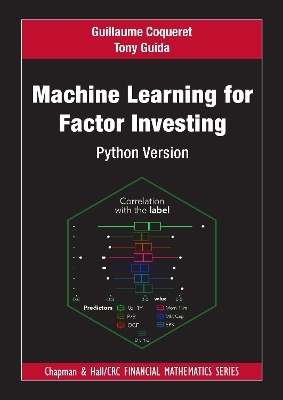
Machine Learning for Factor Investing
Chapman & Hall/CRC (Verlag)
978-0-367-63972-3 (ISBN)
The book covers a wide array of subjects which range from economic rationales to rigorous portfolio back-testing and encompass both data processing and model interpretability. Common supervised learning algorithms such as tree models and neural networks are explained in the context of style investing and the reader can also dig into more complex techniques like autoencoder asset returns, Bayesian additive trees and causal models.
All topics are illustrated with self-contained Python code samples and snippets that are applied to a large public dataset that contains over 90 predictors. The material is available online so that readers can reproduce and enhance the examples at their convenience. If you have even a basic knowledge of quantitative finance, this combination of theoretical concepts and practical illustrations will help you learn quickly and deepen your financial and technical expertise.
Guillaume Coqueret is associate professor of finance and data science at EMLYON Business School. His recent research revolves around applications of machine learning tools in financial economics. Tony Guida is co-head of Systematic Macro at RAM Active Investments. He is the editor and co-author of Big Data and Machine Learning in Quantitative Investment.
Part 1. Introduction 1. Notations and data 2. Introduction 3. Factor investing and asset pricing anomalies 4. Data preprocessing Part 2. Common supervised algorithms 5. Penalized regressions and sparse hedging for minimum variance portfolios 6. Tree-based methods 7. Neural networks 8. Support vector machines 9. Bayesian methods Part 3. From predictions to portfolios 10. Validating and tuning 11. Ensemble models 12. Portfolio backtesting Part 4. Further important topics 13. Interpretability 14. Two key concepts: causality and non-stationarity 15. Unsupervised learning 16. Reinforcement learning Part 5. Appendix 17. Data description 18. Solutions to exercises
| Erscheinungsdatum | 10.08.2023 |
|---|---|
| Reihe/Serie | Chapman and Hall/CRC Financial Mathematics Series |
| Zusatzinfo | 15 Tables, black and white; 80 Line drawings, color; 7 Line drawings, black and white; 1 Halftones, color; 81 Illustrations, color; 7 Illustrations, black and white |
| Sprache | englisch |
| Maße | 178 x 254 mm |
| Gewicht | 662 g |
| Themenwelt | Informatik ► Theorie / Studium ► Künstliche Intelligenz / Robotik |
| Mathematik / Informatik ► Mathematik ► Angewandte Mathematik | |
| Wirtschaft ► Betriebswirtschaft / Management ► Finanzierung | |
| Wirtschaft ► Volkswirtschaftslehre ► Ökonometrie | |
| ISBN-10 | 0-367-63972-6 / 0367639726 |
| ISBN-13 | 978-0-367-63972-3 / 9780367639723 |
| Zustand | Neuware |
| Haben Sie eine Frage zum Produkt? |
aus dem Bereich


